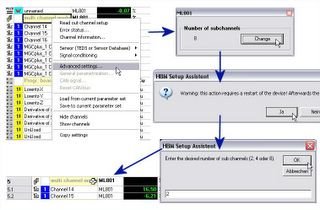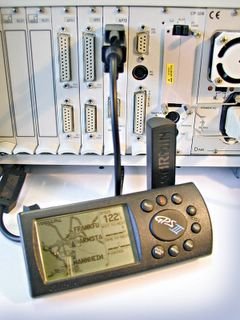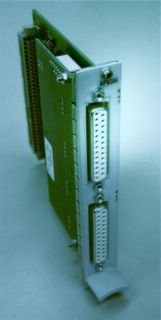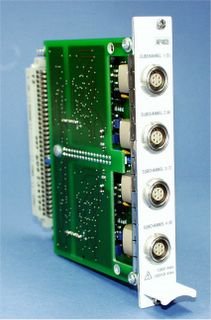Mit MGCplus ist es möglich, Messdaten auf PCcards in den Kommunikationsprozessoren CP32 und CP42 abzuspeichern. Diese Dateien haben die Endungen *.mea, *.me1 und *.me2.
Das Dokument beschreibt das Format der MGCplus-Messdateien...
Friday, October 09, 2009
Description catman binary format
Under this link you'll find a tabled description of the catman binary format...
MGCplus in LabView - based upon catman activeX

The linked pdf is a VI documentation, where we read measurement data from MGCplus.
When the VI is started, you can select a catman IO-Definition.
If the IO-Definition does not exist, a catman dialogue appears, where you can create a new IO definition.
Then the measurement starts with the desired sample rate.
Three signal will be acquired in this example. You can define, which signals.
This can be a time signal and two measured values or three signals.
During measurement, you can change the selection of signals.
In this VI a ringbuffer for the three acquired signals is implements.
The size of ringbuffer can be changed during measurement.
MGCplus - The magic PRG terminal command
On Request a link to a PDF document with the description of the PRG terminal command for MGCplus...
Wednesday, December 06, 2006
Solving a ML70 Login Problem

Problem description
After several login processes with CoDeSys onto the special function module ML70B for MGCplus (older hardware revisions of ML70B), it can happen that further login processes are not possible anymore. The number of login processes can not be determined, because also the duration of Login phases are relevant.
Reason
On the circuit board of ML70B a Tantal-Electrolyt capacity was soldered in with wrong polarity. The value of the capacity is 1.5µF (25V)
Help
>> Soldering out the capacity and
>> soldering in with reversed polarity or soldering in a new capacity
Where can i find this capacity ?
On the picture the capacity is shown with wrong polarity!
Anschlussplatten-Flags für ML801
MGCplus ML801 AP-Flags (ab P5.11)
Durch die AP-Flags können einige Einstellungen des ML801 von der aktuellen Anschlußplatte vorgegeben werden. Diese sind (Schiebefaktor in Klammern):
• CDV-Lock-Flag (1)
• TAV-Lock-Flag (16)
• ACL-Lock-Flag (256)
• ACL-Flag (4096)
Jedem dieser Flags kann man folgende Eigenschaften geben (in Klammern die Kodierung):
• Flag aus / an (1)
• Bei der Werkseinstellung (2)
• Beim Kaltstart (4)
• Immer (8)
Beispiel: Flag soll bei Werkseinstellung und Kaltstart „an“ sein:
4+2+1 = 7, immer „aus“ wäre 8+0 = 8.
Es können nur alle Flags gleichzeitig eingestellt werden. Dazu wird der jeweilige Eigenschaftswert mit dem Schiebefaktor multipliziert und aufsummiert.
Beispiel:
ACL-Flag soll bei Werkseinstellung an und verriegelt sein, alle anderen Flags werden nicht voreingestellt:
3*4096 + 3*256 = 13056.
Dieses Wort muß mit dem folgenden Befehl eingegeben werden:
PRG 820,Flagwort,“SYSTEM“
Natürlich muß vorher der richtige Einschub gewählt werden, z.B. PCS 3 und es müssen unbedingt alle Unterkanäle selektiert sein: SCS-1.
Den Erfolg kann man mit PRG?820 überprüfen, alle Unterkanäle liefern dieselbe Antwort.
Mit PRG 820,0,“SYSTEM“ verschwindet der Spuk komplett wieder.
Die Verstärker-Firmware im ML801 muß mindestens P5.11 sein. Das ACL-Lock-Flag wird im AB22 erst ab P3.44 am Leben gelassen, ältere Versionen löschen es, sobald CDV- oder TAV-Flag verändert werden.
MGCplus ML801 freie Autocal-Zeiten (ab P5.12)
Ab P5.12 kann jede Anschlußplatte die Autocal-Zeiten selbst vorgeben (15s .. 40min). Dazu wird der Befehl PRG 821,Zeit_in_sec,“SYSTEM“ benutzt.Vorher muß der richtige Einschub gewählt werden, z.B. PCS 3 und es müssen unbedingt alle Unterkanäle selektiert sein: SCS-1. Erfolg kann mit PRG?821 überprüft werden. PRG 821,90,“SYSTEM“ stellt damit den Zyklus auf 1,5min. Diese Einstellung ist fest in der Apxxx gespeichert, nicht im ML801. Sie kann mit PRG 821,0,“SYSTEM“ wieder beseitigt werden.
Wenn das Gerät oder die Autokalibrierung eingeschaltet wird, erfolgt die erste Autokalibrierung nahezu sofort, dann immer wieder nach der gewählten Zeit. Ohne diese Vorwahl erfolgt sie sofort, dann nach 1min, 4min später und dann alle 5min.
Durch die AP-Flags können einige Einstellungen des ML801 von der aktuellen Anschlußplatte vorgegeben werden. Diese sind (Schiebefaktor in Klammern):
• CDV-Lock-Flag (1)
• TAV-Lock-Flag (16)
• ACL-Lock-Flag (256)
• ACL-Flag (4096)
Jedem dieser Flags kann man folgende Eigenschaften geben (in Klammern die Kodierung):
• Flag aus / an (1)
• Bei der Werkseinstellung (2)
• Beim Kaltstart (4)
• Immer (8)
Beispiel: Flag soll bei Werkseinstellung und Kaltstart „an“ sein:
4+2+1 = 7, immer „aus“ wäre 8+0 = 8.
Es können nur alle Flags gleichzeitig eingestellt werden. Dazu wird der jeweilige Eigenschaftswert mit dem Schiebefaktor multipliziert und aufsummiert.
Beispiel:
ACL-Flag soll bei Werkseinstellung an und verriegelt sein, alle anderen Flags werden nicht voreingestellt:
3*4096 + 3*256 = 13056.
Dieses Wort muß mit dem folgenden Befehl eingegeben werden:
PRG 820,Flagwort,“SYSTEM“
Natürlich muß vorher der richtige Einschub gewählt werden, z.B. PCS 3 und es müssen unbedingt alle Unterkanäle selektiert sein: SCS-1.
Den Erfolg kann man mit PRG?820 überprüfen, alle Unterkanäle liefern dieselbe Antwort.
Mit PRG 820,0,“SYSTEM“ verschwindet der Spuk komplett wieder.
Die Verstärker-Firmware im ML801 muß mindestens P5.11 sein. Das ACL-Lock-Flag wird im AB22 erst ab P3.44 am Leben gelassen, ältere Versionen löschen es, sobald CDV- oder TAV-Flag verändert werden.
MGCplus ML801 freie Autocal-Zeiten (ab P5.12)
Ab P5.12 kann jede Anschlußplatte die Autocal-Zeiten selbst vorgeben (15s .. 40min). Dazu wird der Befehl PRG 821,Zeit_in_sec,“SYSTEM“ benutzt.Vorher muß der richtige Einschub gewählt werden, z.B. PCS 3 und es müssen unbedingt alle Unterkanäle selektiert sein: SCS-1. Erfolg kann mit PRG?821 überprüft werden. PRG 821,90,“SYSTEM“ stellt damit den Zyklus auf 1,5min. Diese Einstellung ist fest in der Apxxx gespeichert, nicht im ML801. Sie kann mit PRG 821,0,“SYSTEM“ wieder beseitigt werden.
Wenn das Gerät oder die Autokalibrierung eingeschaltet wird, erfolgt die erste Autokalibrierung nahezu sofort, dann immer wieder nach der gewählten Zeit. Ohne diese Vorwahl erfolgt sie sofort, dann nach 1min, 4min später und dann alle 5min.
How to start with CoDeSys and MGCplus

Many times you have new hardware and software and you ask yourself: "Where and how should i start?" In order to help you finding a good entry to CoDeSys programming (with ML70 and MGCplus as Hardware Target), please have a look at the graphic.
It shows you the basic way, how to proceed.
Please have also a look on the CoDeSys FAQ's on the 3S-Homepage
Tuesday, December 05, 2006
NI Diadem Data Plugin for HBM catman data
National Instruments Data Plugin for MGCplus Data files
ML70 for MGCplus: MPA article, Getriebeuntersuchung


In the article of MPA (Germany), the practical realization of gearbox testing is described. Analysis is performed by the Soft PLC ML70 in the MGCplus system.
Nice Application !
Article is written in german language...
MatLab: Example for Online Data Acquisition with catman
In the MathWorks Central File Exchange you can find an example, which shows how to acquire data with MatLab from MGCplus, Spider8 or any other measurement device, which is supported by catman.
The main part of acquiring data is the catman activeX interface (with that you can even get measurement data directly into excel...)
In order to play with the example:
If you do not have a MGCplus or Spider8, Buy one !
You also need the catman activeX Software...
... and for sure MatLab.
The zipped file contains two MATLAB M-files, which show how to access catman activeX functionality. Create and open IO definitions, initializing and starting DAQ, writing values to catman database, accessing the values from matlab. Additionaly, the complete description of catman activeX is contained.
The main part of acquiring data is the catman activeX interface (with that you can even get measurement data directly into excel...)
In order to play with the example:
If you do not have a MGCplus or Spider8, Buy one !
You also need the catman activeX Software...
... and for sure MatLab.
The zipped file contains two MATLAB M-files, which show how to access catman activeX functionality. Create and open IO definitions, initializing and starting DAQ, writing values to catman database, accessing the values from matlab. Additionaly, the complete description of catman activeX is contained.
MatLab M-Files for import of HBM catman data
With these matlab M-files the import of catman binary data files into MatLab is enabled.
A description of the catman binary format can be found here...
The typical use in MatLab:
[a1,a2]=catman_read; % Select a catman file
disp(a1.comment); % Show file comment
disp(a2(1).ChannelName); % Show Name of 1st catman channel...
plot(a2(1).data,a2(2).data); % Plot data
A description of the catman binary format can be found here...
The typical use in MatLab:
[a1,a2]=catman_read; % Select a catman file
disp(a1.comment); % Show file comment
disp(a2(1).ChannelName); % Show Name of 1st catman channel...
plot(a2(1).data,a2(2).data); % Plot data
MatLab M-Files for Import of MGCplus Data Files
The MatLab M-Files in the Mathworks Central file exchange allow the import of MGCplus-files with extension *.me*, which are created during data acquisition with MGCplus and MGCsplit sytems on CP32B and CP42.
The latest version can always be found on the mathworks site, not on the HBM site!
The m-files allow also reading compressed data files with extension *.st*.
CoDeSys Library (Hardware independent)

Useful mathematical functions for the calculation of complex expressions e.g. hyperbolic angle functions, statistic functions and more. In the ZIP file there are CoDeSys example projects included which access on the routines in the library.
This library is hardware (target) independent.
This library is absolutely free !
If you install CoDeSys from the MGCplus System CD, you will find it in your target subdirectories.
A PDF description can be found here....
Wednesday, April 26, 2006
ML70 Debug Cable
Thursday, April 20, 2006
Higher Sample Rates with ML801B

Higher Sample rates with ML801B for MGCplus: Use MGCplus Assistant, mark ML801B channel, then right click: Choose advanced settings and change subchannel count as described. With 4 channels you can have sample rates up to 4.8kHz, with 2 subchannels you can even sample with 9600Hz. All measurements are taken synchoneous !

Tuesday, April 18, 2006
MGCplus, catman and SciLab...

The HBM amplifier system MGCplus is used worldwide in different applications. Measurement data can be acquired on PC cards (stand alone usage) or with the HBM software catman.
For professional post process analysis this data can be imported directly into SciLab (Free MatLab Clone http://scilabsoft.inria.fr/). Import filter are available in the contribution area.
Catman and MGC data can be used easily in SciLab. Data format and source codes are available. Programmers are invited to optimize everything for individual applications.

Thursday, April 13, 2006
AP836i: Poti & Voltages with TEDS for MGC+
Voltage and Current Measurement with MGCplus
Monday, April 03, 2006
Contact Information to HBM
Hi,
in order to get fast contact to HBM, here some internet adresses:
http://www.hbm.com
http://www.hbm.com/data/softdoc/hbm/start.htm
The 2nd adress is the direct link to the complete documentation. In my eyes, this should be the official startpage, because the page gives the best overview over products and their technical documentation.
Best Regards
in order to get fast contact to HBM, here some internet adresses:
http://www.hbm.com
http://www.hbm.com/data/softdoc/hbm/start.htm
The 2nd adress is the direct link to the complete documentation. In my eyes, this should be the official startpage, because the page gives the best overview over products and their technical documentation.
Best Regards
Friday, March 31, 2006
Introducing the MGCplus FAN corner
Hi all,
i have to do a lot of things with the amplifier system MGCplus from HBM (Hottinger Baldwin Messtechnik). I've created this blog in order to post my experiences into the world. I hope, i get many informations from the rest of world. Sharing experiences, building up communities, getting contact to people who have to work also with that powerful DAQ system.
I know, there are so many functions in that system i haven't tried yet. I am not a expert in DAQ, but i can do my basic works quite well.
May be, this Blog will be successful.
Best Regards
Your MGCmaster :-)
i have to do a lot of things with the amplifier system MGCplus from HBM (Hottinger Baldwin Messtechnik). I've created this blog in order to post my experiences into the world. I hope, i get many informations from the rest of world. Sharing experiences, building up communities, getting contact to people who have to work also with that powerful DAQ system.
I know, there are so many functions in that system i haven't tried yet. I am not a expert in DAQ, but i can do my basic works quite well.
May be, this Blog will be successful.
Best Regards
Your MGCmaster :-)
Subscribe to:
Comments (Atom)










